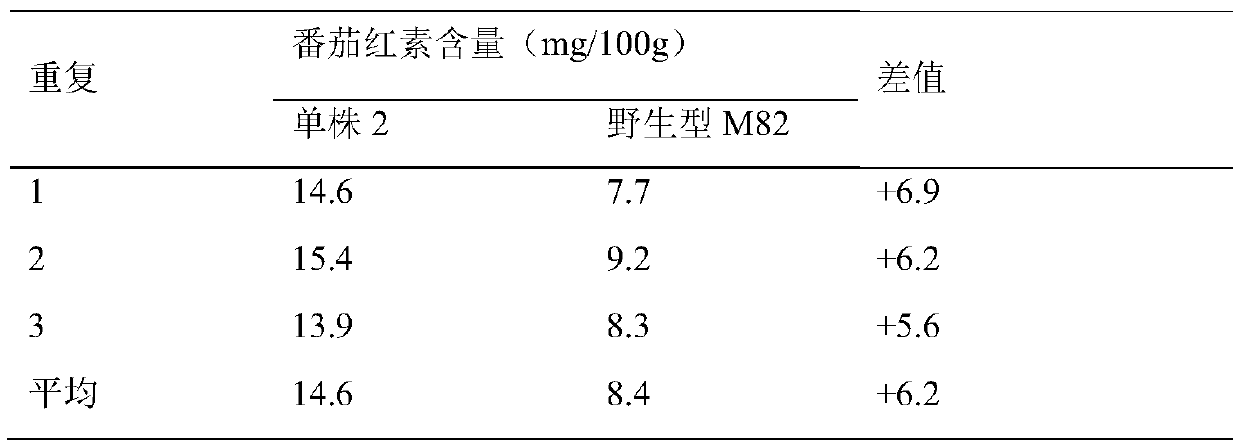Method for making solanum lycopersicum materials having high fruit lycopene content
A high lycopene, fruit technology, applied in the field of plant genetic engineering and genetic modification, can solve the time-consuming and labor-intensive problems of tomatoes, achieve good application prospects, and increase the effect of content
- Summary
- Abstract
- Description
- Claims
- Application Information
AI Technical Summary
Problems solved by technology
Method used
Image
Examples
Embodiment 1
[0010] Example 1: (1) The gene SISGR1, which controls the lycopene content of tomato fruit, is subjected to sequence analysis, and the CRISPR-Plant online design tool is used to design two target sites according to the principle of CRISPR / Cas9 technology design target sites. On the first exon and the second exon, the distance between the two target sequences is 260bp; the sequence of the first gRNA target site is: 5'-TCTAAGCTCAACAATGAACA-3'; (located in SEQ ID NO. 222-241 from the 5' end in 1); the sequence of the second gRNA target site is: 5'-AGAACATATACACTGACTCA-3'; (located at positions 502-521 from the 5' end in SEQ ID NO.1)
Embodiment 2
[0011] Example 2. The method for creating tomato material with high lycopene content in fruit: (1) by enzyme cutting and ligation, two gRNAs are integrated into the constructed plant expression vector pCGR1301-CRISPR / Cas9 to obtain pCGR1301-CRISPR / Cas9-gRNA vector; (2) import the pCGR1301-CRISPR / Cas9-gRNA expression vector into Agrobacterium to obtain pCGR1301-CRISPR / Cas9-gRNA Agrobacterium; (3) tomato with low lycopene content (containing SISGR1 gene ) as material, infect the hypocotyl tissue with pCGR1301-CRISPR / Cas9-gRNA Agrobacterium; (4) Induce callus, and screen for kanamycin resistance to obtain transgenic positive plants; (5) Obtain positive transgenic After the T0 generation of the strain, extract the genomic DNA, design primers on both sides of the target site, perform PCR amplification on the target fragment, purify the PCR amplification product and perform sequencing, screen homozygous mutants according to the sequencing results, and detect the T0 generation The l...
Embodiment 3
[0012] Example 3. The application of creating mutants with high lycopene content based on CRISPR / Cas9 technology in tomato breeding. Specifically, the tomato mutant with high lycopene content, which is homozygous for mutation of SISGR1 and has no foreign aid gene insertion, is selected as material, and tomato breeding with high lycopene content is carried out through breeding techniques such as hybridization; (1) SISGR1 gene sequence is as follows: Shown in SEQ ID NO.1 (2629bp); wherein, the coding sequence (CDS) of the SISGR1 gene consists of the 189th to 305th base, the 406th to 579th base, the 406th to 579th base, The 1698th to 1865th base and the 2033rd to 2392th base are composed; the CRISPR / Cas9 backbone vector described in (2) is pCGR1301; the Agrobacterium described in the step (3) is Rhizobacillus GV3101.
PUM
 Login to View More
Login to View More Abstract
Description
Claims
Application Information
 Login to View More
Login to View More - R&D Engineer
- R&D Manager
- IP Professional
- Industry Leading Data Capabilities
- Powerful AI technology
- Patent DNA Extraction
Browse by: Latest US Patents, China's latest patents, Technical Efficacy Thesaurus, Application Domain, Technology Topic, Popular Technical Reports.
© 2024 PatSnap. All rights reserved.Legal|Privacy policy|Modern Slavery Act Transparency Statement|Sitemap|About US| Contact US: help@patsnap.com










